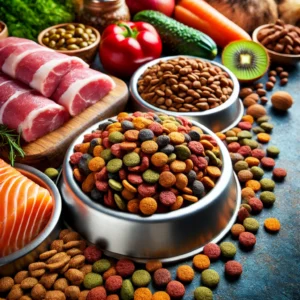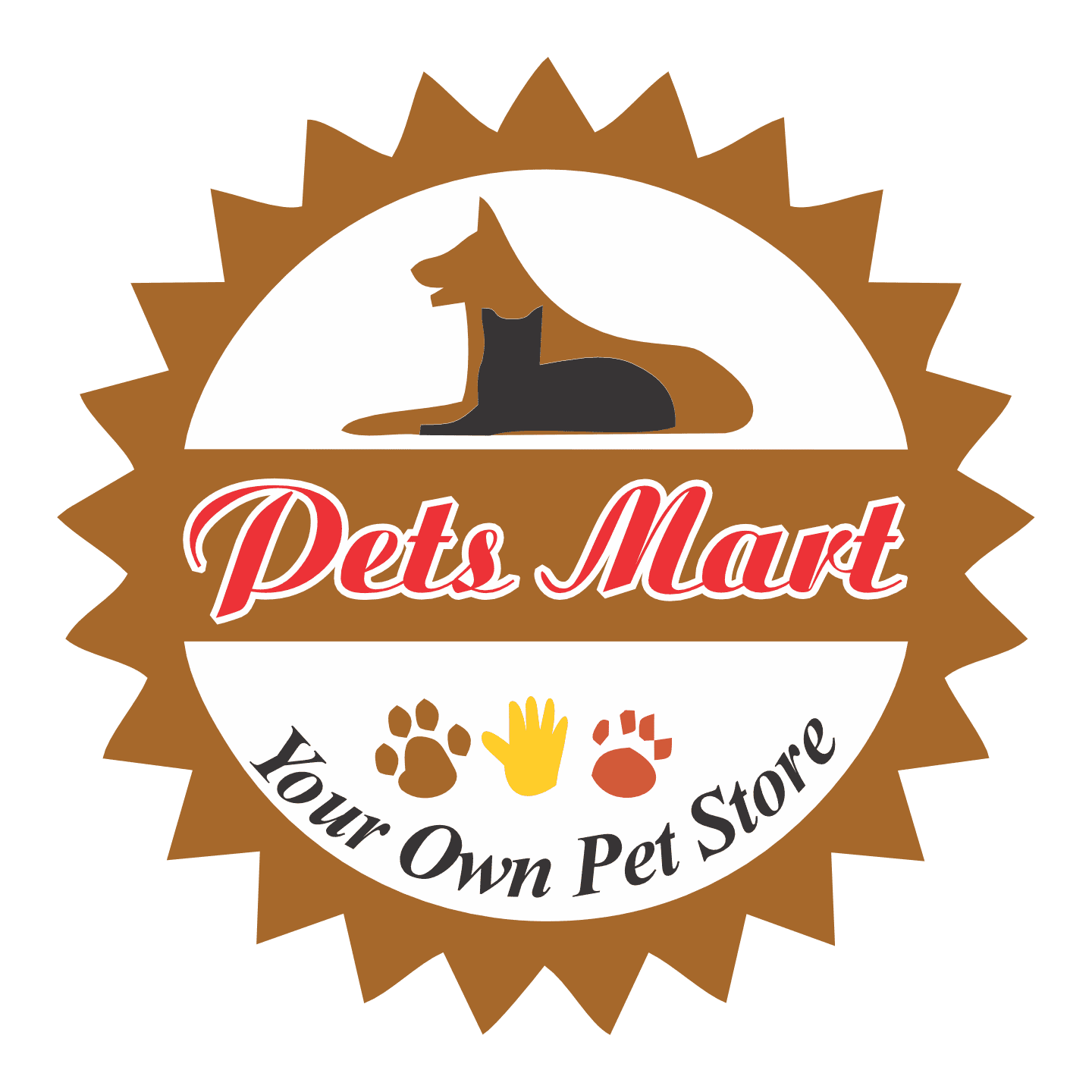Pet owners worldwide agree that a healthy diet is crucial for their pets’ well-being. With the wide array of options available, choosing the best pet food can be daunting. From cats to dogs, each species has specific dietary needs that must be met for them to thrive. Whether you’re a seasoned pet owner or new to the responsibility, understanding pet food’s essentials will ensure your furry friend enjoys a happy and healthy life.
At Pet Mart, we’re committed to providing the best pet food for your beloved animals, whether you need premium dog food, high-quality cat food, or something specialized. This guide will explore everything you need to know about pet food, how to make the right choices, and answer some frequently asked questions to help you navigate the choices in today’s market.

Table of Contents
- What is Pet Food?
- The Importance of Proper Nutrition for Pets
- Types of Pet Food
- Choosing the Best Pet Food for Cats
- Choosing the Best Pet Food for Dogs
- Reading Pet Food Labels: What to Look For
- Common Pet Food Myths Debunked
- How to Transition Your Pet to New Food
- Pet Food for Special Dietary Needs
- FAQs about Pet Food
 1. What is Pet Food?
1. What is Pet Food?
Pet food refers to the commercially prepared food designed specifically for the consumption of domesticated animals like dogs and cats. It typically comes in dry (kibble), wet (canned), or semi-moist forms and is formulated to meet the nutritional needs of specific animals. Pet food is created using a combination of protein sources, carbohydrates, fats, vitamins, and minerals essential for the pet’s overall health.
Why is Pet Food Important?
Feeding pets high-quality food is crucial to maintaining their physical health, mental sharpness, and energy levels. Just like humans, pets require balanced diets filled with the right nutrients to support their immune systems, digestion, skin and coat health, and prevent chronic illnesses.
At Pet Mart, we understand the importance of these requirements and curate a selection of foods that cater to different pet preferences, life stages, and health conditions.
2. The Importance of Proper Nutrition for Pets
Proper nutrition is vital to your pet’s well-being. Whether you have a cat or dog, balanced meals ensure that your pet stays energetic, maintains a healthy weight, and is less susceptible to diseases.
Key Benefits of Balanced Pet Nutrition
- Optimal Growth and Development: Especially in young animals, proper nutrients are needed for healthy bone, muscle, and organ development.
- Immune System Support: A well-balanced diet helps strengthen the immune system, making your pet less prone to infections and illnesses.
- Healthy Skin and Coat: Fatty acids and essential oils found in quality pet food contribute to a shiny coat and healthy skin.
- Increased Longevity: Feeding your pet the right food can contribute to a longer, healthier life.
Investing in high-quality pet food can prevent costly veterinary bills related to poor nutrition or malnutrition. Providing pets with food that aligns with their specific needs means they can lead more vibrant lives, with fewer health problems.
3. Types of Pet Food
There are several types of pet food available on the market, each offering unique benefits. Understanding these can help you make an informed decision about what to feed your pet.
Dry Pet Food (Kibble)
Dry food is one of the most common types available. It’s convenient, affordable, and helps keep pets’ teeth clean due to its crunchy texture. It typically has a long shelf life and is easy to store.
Wet Pet Food (Canned)
Wet pet food contains a higher moisture content and is ideal for pets that might not drink enough water. It’s more flavorful, which is perfect for picky eaters. The downside is that wet food often has a shorter shelf life once opened.
Semi-Moist Food
Semi-moist food combines the benefits of both dry and wet food. It often contains added sugars and salts to maintain its moisture, so it may not always be the healthiest option for regular feeding.
Raw and Freeze-Dried Food
Some pet owners opt for raw or freeze-dried food due to its natural ingredients and high protein content. This type of food often contains uncooked meat, bones, and organs, aiming to mimic a pet’s ancestral diet.
Grain-Free and Special Diet Pet Food
Grain-free foods are often chosen by owners who believe their pets have grain allergies or sensitivities. These foods rely on alternative carbohydrate sources like potatoes or peas. Additionally, there are options available for pets with special dietary needs, such as low-fat diets for overweight pets or hypoallergenic food for pets with sensitivities.
4. Choosing the Best Pet Food for Cats
Nutritional Needs of Cats
Cats are obligate carnivores, meaning their diets must contain animal-based proteins for survival. A diet rich in taurine, an amino acid found in meat, is essential for cats as they cannot produce it on their own. Other important nutrients include omega fatty acids for coat health, antioxidants for immune support, and prebiotics for digestive health.
Best Cat Food Options
- Dry Cat Food: Convenient and affordable, though lower in moisture.
- Wet Cat Food: High moisture content, good for hydration.
- Grain-Free: Suitable for cats with sensitivities or allergies.
Common Cat Food Ingredients to Avoid
- Artificial Preservatives: Avoid BHA, BHT, and ethoxyquin.
- Excessive Fillers: Corn, soy, and wheat are often used as fillers and can cause digestive issues.
5. Choosing the Best Pet Food for Dogs
Nutritional Needs of Dogs
Dogs are omnivores, meaning they can thrive on both animal and plant-based diets. However, their diet should primarily consist of high-quality proteins, healthy fats, and digestible carbohydrates.
Best Dog Food Options
- Kibble: Affordable and effective for dental hygiene.
- Canned Food: High in moisture and taste, ideal for picky eaters.
- Raw Food: Mimics ancestral diets, high in proteins.
- Specialized Diets: Grain-free, low-fat, and hypoallergenic options for dogs with sensitivities.
Common Dog Food Ingredients to Avoid
- Artificial Colors and Flavors: They offer no nutritional value and can trigger allergies.
- High Amounts of Fillers: Corn, soy, and wheat can cause obesity and digestive issues.
6. Reading Pet Food Labels: What to Look For
Understanding pet food labels is essential for making informed decisions. Here’s how you can read them effectively:
Key Ingredients
- Protein Sources: Look for named meat sources like chicken, lamb, or beef as the first ingredient.
- Fat Content: Healthy fats like fish oil or chicken fat should be present for coat health.
- Carbohydrates: Whole grains, sweet potatoes, or peas are better choices than fillers.
Guaranteed Analysis
This section lists the percentages of protein, fat, fiber, and moisture. Make sure the protein content is adequate for your pet’s needs.
AAFCO Statement
Look for a statement from the Association of American Feed Control Officials (AAFCO), which ensures that the food meets the minimum standards for complete and balanced nutrition.
7. Common Pet Food Myths Debunked
Myth 1: Grain-Free Food is Always Better
Many pet owners believe that grain-free food is healthier. However, grains provide essential nutrients, and unless your pet has a specific allergy, grain-inclusive diets can be perfectly healthy.
Myth 2: By-products are Harmful
By-products can include organ meats that are nutritious for pets. Not all by-products are bad, but it’s essential to know the source and quality.
Myth 3: Raw Food is the Only Natural Option
While raw food mimics an ancestral diet, it comes with risks, including bacterial contamination. High-quality commercial diets are balanced and safer for daily feeding.
8. How to Transition Your Pet to New Food
When changing your pet’s diet, it’s crucial to do so gradually to avoid digestive upset. Follow this simple transition process:
- Day 1-2: Mix 25% new food with 75% current food.
- Day 3-4: Mix 50% new food with 50% current food.
- Day 5-6: Mix 75% new food with 25% current food.
- Day 7: Fully transition to new food.
9. Pet Food for Special Dietary Needs
Some pets require specialized diets due to health conditions:
- Senior Pets: Lower calorie and higher fiber content to support aging bodies.
- Pets with Allergies: Limited ingredient diets to avoid allergens.
- Overweight Pets: Low-fat and high-fiber diets to support weight loss.
10. FAQs about Pet Food
1. What should I look for in high-quality pet food?
Look for whole, named meat sources as the first ingredient, no artificial preservatives, and minimal fillers like corn or soy. A good pet food will also contain healthy fats and necessary vitamins.
2. How much food should I feed my pet?
The amount of food varies based on the pet’s weight, age, and activity level. Follow the feeding guidelines on the food packaging or consult your vet for a more personalized plan.
3. Can I feed my pet human food?
Some human foods are safe for pets, but others like chocolate, onions, and grapes can be toxic. It’s best to stick to specially formulated pet food to ensure their safety.
4. Should I consult a vet before switching pet food?
Yes, it’s always a good idea to consult your veterinarian before making significant changes to your pet’s diet, especially if your pet has any underlying health issues.
5. Is raw food safe for pets?
Raw food diets can be beneficial, but they also come with risks, such as bacterial contamination. Always handle raw food carefully and consult your vet before making the switch.
Conclusion
Choosing the best pet food can seem overwhelming, but by understanding the basics of nutrition, types of food, and reading labels, you can make an informed decision that ensures your pet leads a happy, healthy life. Always consult your vet for tailored advice and keep your pet’s unique needs in mind when selecting their food.
Take the time to invest in high-quality food—your furry friend’s health and happiness are worth it!

